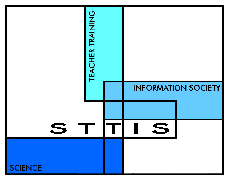Workshop 1
 Contents Contents
|
Section
B Learning about the innovation
Activity
B4 Dealing with several variables |
|
Aims
-
To learn how a spreadsheet
can be used to explore
more complex relationships in which there are several variables.
-
To consider the usefulness
of these models in teaching
and learning.
Background
In the first activity, you
looked at models of simple
relationships involving three variables, one of which was calculated
from
the other two. The models in this activity involve many variables. They
each have three or four independent variables, and a number of
dependent
variables. This means that pupils would need to be systematic in the
way
in which they explore and interpret the behaviour of such models.
| For this activity you will need
to open two spreadsheet workbooks. Each model is on a different sheet
in
the workbooks. There are notes on each model - point to the first cell
to display the comment. |
Force and motion

Download ‘models4a'
|
Electricity

Download ‘models4b'
|
What to do
1. Model 4a.1 (page
2) represents the behaviour of an object that is acted on by
a constant
force. Since both F and m are constants in this model, and a
= F
/m , then a is constant, and
this model is similar to Model
3a.1 which shows the behaviour of an object with a constant
acceleration.
What effect would you predict on the graphs of changing the mass? What
effect would you predict of changing the force?
2. Model
4a.2 (page
3) is similar to the previous model, except that it
represents an object
being acted on by two opposite forces. What effects would you predict
on
the graphs of changing the mass, the initial velocity, and the two
forces?
What would you expect to happen if the two forces were equal to each
other?
3. Model
4b.1 (page
4) is concerned with the power output of a circuit containing
three
lamps, two of which are in parallel. What effect do you think changing
V would have on the power output of each lamp and on the total power
output?
What effect would you predict on the total power output and the output
of each lamp if one of the resistances was changed?
4. Do you
think that these models are useful
in the classroom? What age pupils do you think that they are suitable
for?
How would you integrate these activities into your existing teaching?
Can
you think of any improvements that you would like to make to these
models?
|

 Teaching with computer models
Teaching with computer models

